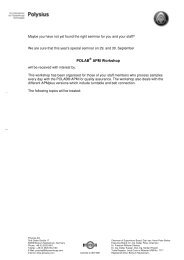From the vise to heavy plant engineering - Polysius
From the vise to heavy plant engineering - Polysius
From the vise to heavy plant engineering - Polysius
You also want an ePaper? Increase the reach of your titles
YUMPU automatically turns print PDFs into web optimized ePapers that Google loves.
<strong>From</strong> <strong>the</strong> <strong>vise</strong> <strong>to</strong> <strong>heavy</strong> <strong>plant</strong> <strong>engineering</strong><br />
In 1859, master machinist Andreas Ernst Gottfried <strong>Polysius</strong> (Fig. 1) established his<br />
own workshop in Dessau and thus laid <strong>the</strong> foundation s<strong>to</strong>ne for <strong>to</strong>day's global player<br />
- <strong>Polysius</strong> AG.<br />
A Shepherd Turned Machinist<br />
Andreas Ernst Gottfried <strong>Polysius</strong> was born in Dessau on 17 November, 1827. The<br />
son of <strong>the</strong> duke's shepherd was granted <strong>the</strong> privilege of attending grammar school,<br />
but after three years Gottfried had <strong>to</strong> leave school in order <strong>to</strong> help his fa<strong>the</strong>r. Instead<br />
of reading, writing and calculating he had now <strong>to</strong> tend sheep.<br />
In 1848, when he came of age, he wrote a letter <strong>to</strong> his fa<strong>the</strong>r, telling him that he had<br />
earned and saved so much money that he could now afford <strong>to</strong> learn a trade, hoping<br />
that with <strong>the</strong> help of God he would make ends meet.<br />
Gottfried <strong>Polysius</strong> became a machinist and continued <strong>to</strong> pursue his goals with<br />
determination.<br />
In 1859, <strong>the</strong> master machinist opened his own workshop in Dessau, <strong>the</strong> birthplace of<br />
<strong>the</strong> <strong>Polysius</strong> company. At first, he produced soapboxes, small shovels and s<strong>to</strong>ve<br />
pipes. However, <strong>the</strong> 32-year-old craftsman had ambitious plans.<br />
In 1870, he set up <strong>the</strong> G. <strong>Polysius</strong> iron foundry and <strong>engineering</strong> works (Fig. 2), where<br />
he employed 32 workers. Gottfried <strong>Polysius</strong> also manufactured safes. To promote<br />
<strong>the</strong>m, he came up with an extraordinary idea that revealed his self-confidence: He<br />
offered a reward of 100 thalers <strong>to</strong> anybody who would succeed in cracking one of his<br />
safes. He never had <strong>to</strong> pay out <strong>the</strong> reward.<br />
1
After <strong>the</strong> foundation of <strong>the</strong> German Reich in 1871, <strong>the</strong> German economy flourished,<br />
and Gottfried <strong>Polysius</strong> was able <strong>to</strong> increase <strong>the</strong> range of his products considerably.<br />
He wrote a letter <strong>to</strong> his wife Luise, telling her that prospects were good owing <strong>to</strong> a<br />
high demand for water pipes, mills, council offices and railways, so that many orders<br />
were <strong>to</strong> be expected.<br />
Gottfried <strong>Polysius</strong> also kept making wrought-iron products. In July, 1875, he finished<br />
<strong>the</strong> wrought-iron gates for <strong>the</strong> duke's palace in Dessau. He later proudly reported that<br />
<strong>the</strong> gates had been hung at <strong>the</strong> palace and that <strong>the</strong> Duke and his family greatly<br />
admired <strong>the</strong>ir beauty.<br />
What an outstanding achievement this was for a former shepherd.<br />
Two bro<strong>the</strong>rs - one aim<br />
At <strong>the</strong> age of 58, Gottfried <strong>Polysius</strong> died of a heart attack. In 1886, <strong>the</strong> company was<br />
taken over by <strong>the</strong> second generation. Sons Ot<strong>to</strong> und Max <strong>Polysius</strong> realised that <strong>the</strong><br />
cement manufacturing industry, <strong>the</strong>n still in its infancy, promised <strong>to</strong> be a profitable<br />
field of activity and thus paved <strong>the</strong> way <strong>to</strong> a worldwide business.<br />
They purposefully supplied <strong>the</strong> new market with products manufactured in <strong>the</strong><br />
Dessau fac<strong>to</strong>ry. In 1888, Ot<strong>to</strong> <strong>Polysius</strong> wrote that by <strong>the</strong> end of <strong>the</strong> year he had<br />
designed a new type of comminution machine which, owing <strong>to</strong> its high efficiency, had<br />
met with so much success – in particular, in cement grinding <strong>plant</strong>s – that within a<br />
short time he was awarded orders for 24 comminution machines.<br />
The economy continued <strong>to</strong> thrive. In 1890, <strong>the</strong> G. <strong>Polysius</strong> iron foundry and<br />
<strong>engineering</strong> works delivered 70 comminution machines <strong>to</strong> Switzerland, England and<br />
o<strong>the</strong>r countries (Fig. 3). They also supplied transmissions and friction clutches. The<br />
next step was <strong>to</strong> conquer <strong>the</strong> world market.<br />
Chicago, 2 May, 1893 – The World’s Columbian Exposition opened <strong>to</strong> <strong>the</strong> public, as<br />
<strong>the</strong> white city, built of steel and plaster, was celebrating <strong>the</strong> 400th anniversary of <strong>the</strong><br />
discovery of America. 70,000 exhibi<strong>to</strong>rs came <strong>to</strong> Chicago, among <strong>the</strong>m Max <strong>Polysius</strong>.<br />
In <strong>the</strong> machine hall, he presented <strong>the</strong> whole range of products manufactured in <strong>the</strong><br />
Dessau fac<strong>to</strong>ry (Fig. 4). The company's comminution machines German were<br />
expressly mentioned in <strong>the</strong> "Amtlicher Bericht" (official German report on <strong>the</strong><br />
exposition) where <strong>the</strong> reader was informed that G. <strong>Polysius</strong>, located in Dessau,<br />
exhibited four comminution machines of different size for <strong>the</strong> comminution of hard<br />
materials like cement clinker, limes<strong>to</strong>ne, clay, gypsum, fire clay, <strong>heavy</strong> spar, emery,<br />
Thomas slag, bones, colouring matter, salts, alum, ores, broken bricks, etc.<br />
1900: At <strong>the</strong> beginning of <strong>the</strong> new century, <strong>the</strong> order books of G. <strong>Polysius</strong>, Dessau,<br />
were full. A second fac<strong>to</strong>ry, provided with a private railway siding, was erected. The<br />
number of employees increased <strong>to</strong> almost 400.<br />
2
In 1907, <strong>the</strong> first complete cement <strong>plant</strong> was delivered <strong>to</strong> Egypt. Just one year later,<br />
ano<strong>the</strong>r was sent <strong>to</strong> China. <strong>Polysius</strong> had made <strong>the</strong> breakthrough and finally arrived<br />
on <strong>the</strong> world market!<br />
However, this success s<strong>to</strong>ry was abruptly ended by <strong>the</strong> outbreak of World War I in<br />
<strong>the</strong> summer of 1914. Many business contacts were cut off. The demand was now for<br />
cannons instead of cement <strong>plant</strong>s and mills.<br />
In November 1918, World War I was over and <strong>the</strong> former enemies became business<br />
partners once again.<br />
Ot<strong>to</strong> and Max <strong>Polysius</strong> succeeded in regaining <strong>the</strong>ir position on <strong>the</strong> world market, and<br />
foreign currency helped <strong>the</strong>m <strong>to</strong> overcome depression and inflation.<br />
In 1922, <strong>the</strong> offices for design engineers and clerks were extended and a new<br />
labora<strong>to</strong>ry as well as a test <strong>plant</strong> facility were built. Cement <strong>plant</strong>s designed in<br />
Dessau were selling extraordinarily well all over <strong>the</strong> world. In 1927, G. <strong>Polysius</strong>,<br />
Dessau, established a subsidiary in <strong>the</strong> US – <strong>the</strong> <strong>Polysius</strong> Corporation in Bethlehem,<br />
Pennsylvania.<br />
The Third Generation<br />
At <strong>the</strong> end of <strong>the</strong> 1920s, Max and Ot<strong>to</strong> <strong>Polysius</strong> received active support when <strong>the</strong>ir<br />
sons, Ot<strong>to</strong>, Gustav, Walter and Gottfried Karl, started working at <strong>the</strong>ir company.<br />
On 1 July, 1928, <strong>the</strong> legal form of <strong>the</strong> company changed: <strong>the</strong> former general<br />
partnership became an AG, i.e. an Aktiengesellschaft (public limited company). The<br />
shares of <strong>the</strong> company, however, remained in <strong>the</strong> possession of <strong>the</strong> <strong>Polysius</strong> family.<br />
At that time, <strong>the</strong> company also presented a new logo.<br />
When designing <strong>the</strong> first rotary kiln in 1904, G. <strong>Polysius</strong> AG had already made large<br />
investments in research and development.<br />
In 1927, Dr. Georg Lellep designed in cooperation with G. <strong>Polysius</strong>, Dessau, <strong>the</strong> first<br />
LEPOL® kiln, <strong>the</strong>reby starting a revolution that changed <strong>the</strong> traditional cement<br />
production process forever. The new kiln type – named after <strong>the</strong> engineer Dr. Lellep<br />
and <strong>Polysius</strong> – reduced energy consumption by a third.<br />
In 1927, <strong>the</strong> graduate engineer Ot<strong>to</strong> Georg Lellep left Es<strong>to</strong>nia and settled in Dessau.<br />
In cooperation with G. <strong>Polysius</strong>, he designed <strong>the</strong> so-called LEPOL kiln by means of<br />
which <strong>the</strong> calcination process was considerably improved. Over a period of two<br />
years, <strong>the</strong>y carried out extensive tests in order <strong>to</strong> achieve this improvement.<br />
G. <strong>Polysius</strong>, Dessau, invested more than one million gold marks until <strong>the</strong> design and<br />
performance of Lellep's pro<strong>to</strong>type was so much enhanced that <strong>the</strong>y were able <strong>to</strong> put<br />
it in<strong>to</strong> practice.<br />
However, in 1929, in <strong>the</strong> middle of a worldwide depression, it was difficult <strong>to</strong> market<br />
<strong>the</strong> LEPOL kiln. The G. <strong>Polysius</strong> AG, Dessau, suffered a serious and persistent<br />
crisis.<br />
3
In 1933, <strong>the</strong> National Socialists seized power in Germany. They implemented<br />
governmental programmes <strong>to</strong> boost <strong>the</strong> economy. The G. <strong>Polysius</strong> AG also derived<br />
benefit from <strong>the</strong>se programmes, and in <strong>the</strong> following years, <strong>the</strong>y supplied 40<br />
LEPOL kilns per year all over <strong>the</strong> world (Fig. 5).<br />
In 1939, <strong>the</strong> Nazis attacked Poland, thus starting World War II. Many international<br />
business contacts were cut off. The fac<strong>to</strong>ry in Dessau was forced <strong>to</strong> change<br />
production in order <strong>to</strong> meet <strong>the</strong> demands of wartime economy. Instead of cement<br />
<strong>plant</strong>s, <strong>the</strong>y now produced machine components for <strong>the</strong> air force and <strong>the</strong> locomotive<br />
and tank programme.<br />
In 1944, Dessau was reduced <strong>to</strong> debris. However, production at <strong>the</strong> <strong>Polysius</strong> fac<strong>to</strong>ry<br />
continued in spite of damage and difficulties. After <strong>the</strong> end of World War II, <strong>the</strong><br />
fac<strong>to</strong>ry was expropriated by <strong>the</strong> authorities of <strong>the</strong> Soviet occupying forces.<br />
<strong>From</strong> <strong>the</strong>n on, <strong>the</strong> his<strong>to</strong>ry of <strong>the</strong> G. <strong>Polysius</strong> AG followed two different routes: On <strong>the</strong><br />
one hand, <strong>the</strong> former <strong>Polysius</strong> AG in Dessau was transformed in<strong>to</strong> a Soviet joints<strong>to</strong>ck<br />
company in 1946 and renamed VEB Zementanlagenbau in 1953. On <strong>the</strong> o<strong>the</strong>r,<br />
WESTPOL GmbH – predecessor of <strong>the</strong> actual <strong>Polysius</strong> AG – was founded in<br />
Neubeckum (West Germany) in 1946.<br />
End of World War II and Expropriation<br />
In March 1945, Gustav <strong>Polysius</strong> witnessed <strong>the</strong> air raid on Dessau. After <strong>the</strong> end of<br />
World War II, Dessau was first occupied by American troops, <strong>the</strong>n by Soviet troops.<br />
Gustav <strong>Polysius</strong> hoped that <strong>the</strong> company could be saved for his family. So he wrote<br />
letters <strong>to</strong> <strong>the</strong> authorities of <strong>the</strong> occupying forces, declaring that no member of his<br />
family had been a member of <strong>the</strong> NSDAP and that <strong>the</strong> company was one hundred<br />
percent owned by his family, with no Nazi organisation having any stake in it.<br />
The company was forced <strong>to</strong> make reparations <strong>to</strong> <strong>the</strong> USSR. Dr. Curt Prüssing, sonin-law<br />
of Max <strong>Polysius</strong>, founded WESTPOL GmbH in one of <strong>the</strong> Western zones. The<br />
new company <strong>the</strong>n purchased <strong>the</strong> components which Gustav <strong>Polysius</strong> needed for <strong>the</strong><br />
erection of <strong>the</strong> first cement <strong>plant</strong>s in <strong>the</strong> USSR.<br />
Gustav <strong>Polysius</strong> decided against moving <strong>to</strong> <strong>the</strong> Western zone and remained in<br />
Dessau. Then, in July, 1946, it was <strong>to</strong>o late <strong>to</strong> re<strong>vise</strong> his decision. G. <strong>Polysius</strong> AG<br />
was expropriated and Gustav <strong>Polysius</strong> was arrested. He was sent <strong>to</strong> a special Soviet<br />
camp, established on <strong>the</strong> site of <strong>the</strong> former concentration camp Buchenwald, where<br />
he died from starvation and privations on 9 March, 1947.<br />
In 1946, WESTPOL GmbH reassured <strong>the</strong>ir cus<strong>to</strong>mers and business contacts all over<br />
<strong>the</strong> world that, in spite of <strong>the</strong> expropriation of <strong>the</strong> fac<strong>to</strong>ry in Dessau, <strong>Polysius</strong> was<br />
going <strong>to</strong> survive in <strong>the</strong> form of <strong>the</strong> new Neubeckum-based WESTPOL GmbH, which<br />
intended <strong>to</strong> start operations as soon as possible. The newly founded company had <strong>to</strong><br />
take up business under extremely adverse circumstances. The first office of <strong>the</strong> four<br />
employees consisted of two rooms in a basement in 14 Spiekerstraße, Neubeckum<br />
(Fig. 6a).<br />
4
Improvisation skills were in great demand. The staff had <strong>to</strong> borrow desks, chairs and<br />
a typewriter, while paper, pencils and erasers often had <strong>to</strong> be bought on <strong>the</strong> black<br />
market.<br />
The Westpol employees were allowed <strong>to</strong> fell a poplar on <strong>the</strong> premises of <strong>the</strong><br />
Germania cement <strong>plant</strong>. In a combined effort, <strong>the</strong>y felled and sawed up <strong>the</strong> tree and<br />
<strong>the</strong>n traded <strong>the</strong> wood off against <strong>the</strong> first drawing board of <strong>the</strong> new company.<br />
In 1948, <strong>the</strong>y rented larger offices in what was formerly a chemist's shop in<br />
Neubeckum. At <strong>the</strong> same time, work commenced on a new building in 17 Graf-<br />
Galen-Straße, Neubeckum, at <strong>the</strong> very same place where <strong>to</strong>day's headquarters are<br />
still located (Fig. 6b).<br />
<strong>From</strong> Dessau <strong>to</strong> Neubeckum<br />
After <strong>the</strong> end of World War II, Dr. Curt Prüssing ensured <strong>the</strong> continuation of <strong>the</strong><br />
company in West Germany.<br />
Thanks <strong>to</strong> his excellent diplomatic skills, Dr. Prüssing successfully dealt with all <strong>the</strong><br />
obstacles <strong>the</strong> new company had <strong>to</strong> face in post-war Germany. Important design<br />
drawings had been lost in <strong>the</strong> war, and patents and licences were in jeopardy, yet he<br />
succeeded in reviving <strong>the</strong> international contacts of past days. In his memoirs, he<br />
acknowledged that <strong>the</strong>y did not bo<strong>the</strong>r about <strong>the</strong> hundreds of regulations imposed by<br />
or in <strong>the</strong> name of <strong>the</strong> occupying powers because <strong>the</strong>y were determined <strong>to</strong> survive, <strong>to</strong><br />
rebuild <strong>the</strong> company and <strong>to</strong> get back what had been taken from <strong>the</strong>m – <strong>the</strong>se were<br />
<strong>the</strong> goals which motivated <strong>the</strong>ir actions.<br />
1949 WESTPOL becomes <strong>Polysius</strong><br />
On 25 February 1949, <strong>the</strong> shareholders'meeting voted in favour of transforming<br />
WESTPOL GmbH in<strong>to</strong> <strong>Polysius</strong> GmbH. The preceding years had been extremely<br />
difficult and fraught with risk. At first, <strong>the</strong>re had been a lack of all <strong>the</strong> normal<br />
prerequisites for successfully transacting business. Despite <strong>the</strong>se problems, a few<br />
smaller orders for spare-parts were processed in Germany up <strong>to</strong> <strong>the</strong> spring of 1947.<br />
The company was also able <strong>to</strong> supply <strong>the</strong> missing parts for a Lepol kiln that had been<br />
partly delivered <strong>to</strong> a sou<strong>the</strong>rn German cement fac<strong>to</strong>ry during <strong>the</strong> war and <strong>to</strong> erect <strong>the</strong><br />
kiln.<br />
In August of <strong>the</strong> same year a sou<strong>the</strong>rn German cement producer also ordered a<br />
Lepol kiln. Payment was <strong>to</strong> be in <strong>the</strong> form of sawn timber. When <strong>the</strong> first timber<br />
wagon arrived in Neubeckum <strong>the</strong> event was of inconceivable momen<strong>to</strong>usness. With<br />
<strong>the</strong> support of <strong>the</strong> municipal administration of Neubeckum, <strong>Polysius</strong> was given a plot<br />
of building land on Graf-Galen-Straße.<br />
The financial situation continued <strong>to</strong> be extremely tight. The currency reform left <strong>the</strong><br />
company with only DM 12,000. When <strong>the</strong> wages and Christmas bonus were paid out<br />
on Christmas Eve 1948, it was <strong>to</strong>tally unclear where <strong>the</strong> funds would come from <strong>to</strong><br />
pay January's wages. The uncertainty caused some employees <strong>to</strong> accept offers of<br />
5
jobs elsewhere. Then Dr. Curt Prüssing succeeded in selling off <strong>the</strong> last disposable<br />
assets, bringing <strong>Polysius</strong> ano<strong>the</strong>r DM 18,000. This saved <strong>the</strong> life of <strong>the</strong> company.<br />
With <strong>the</strong> traditional name on its new signboard, <strong>the</strong> company proceeded <strong>to</strong> reestablish<br />
itself on <strong>the</strong> world market. In 1953, a small workshop was built and <strong>the</strong><br />
cooperation with Dr. Georg Lellep was renewed in <strong>the</strong> form of a licence agreement.<br />
The company <strong>the</strong>n experienced a business improvement that exceeded all<br />
expectations. The premises doubled in size and a new research centre was built in<br />
1957.<br />
<strong>Polysius</strong> GmbH, <strong>to</strong>ge<strong>the</strong>r with its subsidiaries in England and France now had a<br />
workforce of around 700 and impressively lived up <strong>to</strong> <strong>the</strong> promise that WESTPOL<br />
GmbH had sent <strong>to</strong> its cus<strong>to</strong>mers all over <strong>the</strong> world in 1946 under <strong>the</strong> dramatic<br />
circumstances existing at that time:<br />
The company's worldwide presence was improved by establishing subsidiaries. By<br />
1971 <strong>Polysius</strong> was represented in England, France, Spain and South Africa by<br />
subsidiary firms. Technological developments led <strong>to</strong> a progressive increase in <strong>the</strong><br />
complexity of production <strong>plant</strong>s which, <strong>to</strong>ge<strong>the</strong>r with <strong>the</strong> increasing size of orders,<br />
began <strong>to</strong> exceed <strong>the</strong> financial capacity of <strong>the</strong> company. It was <strong>the</strong>refore only a matter<br />
of time before <strong>the</strong> <strong>Polysius</strong> family had <strong>to</strong> take <strong>the</strong> decision <strong>to</strong> place <strong>the</strong> future of <strong>the</strong><br />
company in better-funded hands.<br />
In 1971, Fried. Krupp GmbH <strong>to</strong>ok over <strong>the</strong> majority shareholding In <strong>Polysius</strong> and<br />
created <strong>the</strong> preconditions for a continuing positive development. It was now possible<br />
for <strong>Polysius</strong> <strong>to</strong> undertake major international projects which it could not have taken on<br />
without <strong>the</strong> financial capacity of <strong>the</strong> new owner. An impressive number of new <strong>plant</strong>s<br />
were constructed all over <strong>the</strong> world. Fur<strong>the</strong>r subsidiaries were established in non-<br />
European countries.<br />
The reunification of Germany and <strong>the</strong> opening of eastern Europe led <strong>to</strong> an enormous<br />
construction boom and a consequent leap in <strong>the</strong> demand for cement. Totally obsolete<br />
cement fac<strong>to</strong>ries had <strong>to</strong> be modernised or - as in <strong>the</strong> case of Bernburg in Saxony-<br />
Anhalt - replaced by a new <strong>plant</strong>. For <strong>Polysius</strong>, <strong>the</strong> foremost considerations when<br />
designing new facilities are environmental protection, increased energy efficiency,<br />
and <strong>the</strong> conservation of natural resources by substituting alternative process<br />
materials.<br />
1992 saw <strong>the</strong> company's incorporation in<strong>to</strong> <strong>the</strong> Krupp <strong>plant</strong>making division. Ano<strong>the</strong>r<br />
decisive miles<strong>to</strong>ne was set when Fried. Krupp AG Hoesch-Krupp merged with <strong>the</strong><br />
Thyssen Group <strong>to</strong> form ThyssenKrupp AG. As a member of <strong>the</strong> international<br />
business segment, ThyssenKrupp Technologies, <strong>Polysius</strong> is well-placed <strong>to</strong> master<br />
<strong>the</strong> challenges of <strong>the</strong> future.<br />
This new strength makes it possible <strong>to</strong> maintain and increase our competitiveness.<br />
Moreover, <strong>Polysius</strong> has made selective acquisitions that have considerably improved<br />
our market presence. New business sec<strong>to</strong>rs have significantly stabilised <strong>the</strong> company<br />
against fluctuations in economic activity.<br />
The eventful his<strong>to</strong>ry of <strong>the</strong> <strong>Polysius</strong> company passes a special obligation from<br />
generation <strong>to</strong> generation. This is <strong>to</strong> keep <strong>the</strong> company's tradition in mind while<br />
6
mastering new challenges through innovation. Many generations have provided good<br />
examples for this business principle.<br />
Maintaining <strong>the</strong> tradition of <strong>the</strong> company also means continuing <strong>to</strong> place team spirit<br />
and loyalty at <strong>the</strong> heart of POLYSIUS corporate culture.<br />
7
Fig. 1
Fig 2
Fig 3
Fig 4
Fig. 5
Fig. 6a
Fig. 6b









